Friday, 10 June 2011: Igé/Cluny to Bourg-en-Bresse
Written 19 June 2011
On Friday, it was good-bye to lovely Igé and on to Bourg-en-Bresse, where the famous Bresse chickens comes from—I've described them in the "Squared Away" entry above.
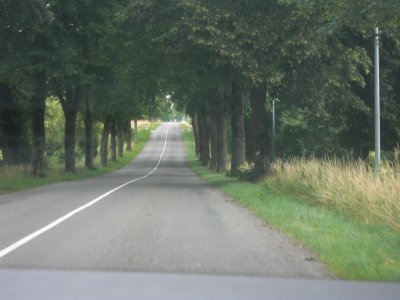
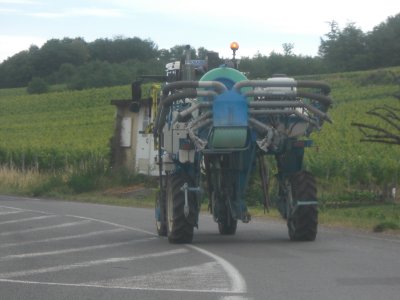 On the way, we drove on several stretches of old Roman road, now tarmac'd over but recognizable by their resolute rectilinearity; they're incredibly durable, but no road can stand 1500 years of neglect and stay smooth. They can, however, remain straight, as this one has (the plane trees have probably been replaced a couple of times).
On the way, we drove on several stretches of old Roman road, now tarmac'd over but recognizable by their resolute rectilinearity; they're incredibly durable, but no road can stand 1500 years of neglect and stay smooth. They can, however, remain straight, as this one has (the plane trees have probably been replaced a couple of times).
Here, also, is my obligatory, annual photo of a piece of vine-cultivation equipment. It shortly pulled over to let us by.
In Bourg, we lost the chain of signs leading toward our hotel when the hotel sign said "Go straight" but the other road signs said "Nobody can go straight here except buses." The city center is a morass of one-way streets, no two at right angles; most intersections are three- or five-way. I managed to keep my sense of direction through the maze until, "Wait, this is the Cour de Verdun! Turn right here!" That put our hotel directly in front of us, where, at its far end, the Cour de Verdun broke into two tiny streets, both one-way, but I didn't know which of the two tiny streets the hotel was on or which way its entrance faced. Happily, it was centered between the two, with its entrance facing us and a small parking lot right there. The nice lady at reception stepped outside to show us the entrance to the hotel's private, indoor, parking lot, just steps away on a smooth surface perfect for rolling luggage. From reception, though, it was five steps up to the elevator. We were on the second floor, so we pressed "2" only to emerge from the elevator onto a landing between two flights of stairs, one up and one down, without other outlet! Fortunately, it was between the second and third floors, and getting our bags down half a floor was much easier than hauling them up a flight and a half would have been.
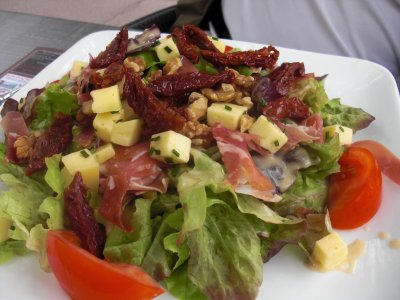
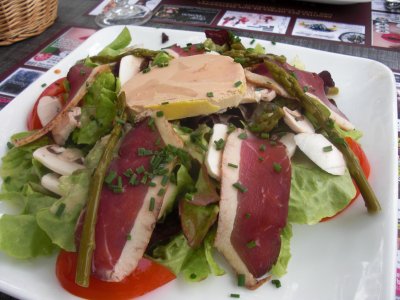 We found lunch at Le Scarron (Paul Scarron, 1610-1660, was a poet who was born and died in Paris, but maybe he worked in Bourg for a while in between), on our way to the Office de Tourisme. Mine was the usual "Gourmande" (this one with duck-breast ham, foie gras, raw mushrooms, and asparagus). I forget the name of David's, but it had raw ham, dried (and fresh) tomato, walnuts, and excellent Tome de Savoie (I definitely taste the kinship with Sweetgrass Dairy's Thomasville Tomme).
We found lunch at Le Scarron (Paul Scarron, 1610-1660, was a poet who was born and died in Paris, but maybe he worked in Bourg for a while in between), on our way to the Office de Tourisme. Mine was the usual "Gourmande" (this one with duck-breast ham, foie gras, raw mushrooms, and asparagus). I forget the name of David's, but it had raw ham, dried (and fresh) tomato, walnuts, and excellent Tome de Savoie (I definitely taste the kinship with Sweetgrass Dairy's Thomasville Tomme).
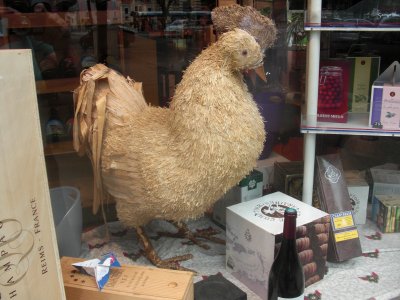
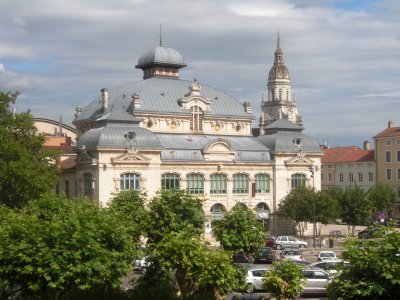 On the way there, we passed this straw chicken in a wine-store window. Chickens are a major theme of design and decoration in the town. All the restaurant plates have chickens on them; both restaurants we ate dinner in had chicken art on the walls (and every other surface).
On the way there, we passed this straw chicken in a wine-store window. Chickens are a major theme of design and decoration in the town. All the restaurant plates have chickens on them; both restaurants we ate dinner in had chicken art on the walls (and every other surface).
We also passed this theater, on the Cours de Verdun. It seems still to be a real theater, as opposed to having been converted to a movie house.
The Office de Tourisme gave us maps and a self-guided walking tour of the town, and they highly recommended the Royal Monastary of Brou, within walking distance south of town. As it happens, our restaurant for the evening was directly across the street from it, so we got a nice look at the exterior later the same day.
Written 20 June 2011
[An aside: I've never finished a trip so far behind on the blog! Clearly, it's going to take me a while to finish it once we get home—I'll have less time to write, and of course my brain will be in a different place. Right now, I'm writing over my second cup of tea in the breakfast room at our hotel in Saint Étienne while I wait for David to wake up and join me. (I brought the electric kettle down from the room so that I could make real tea, with boiling water, rather than having to use the tepid stuff from the thermos carafe on the breakfast bar.) Today we have to pack up and drive back to Lyon, where we'll spend the night and have one more good restaurant meal before, sigh, flying home tomorrow.]
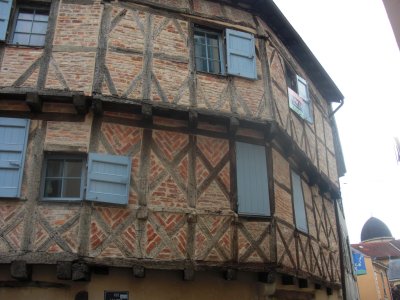
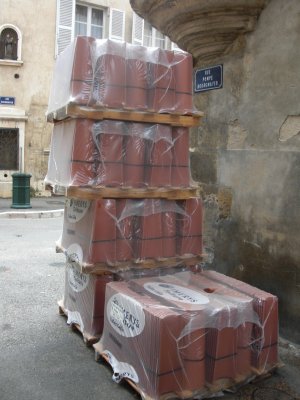 The walking tour mostly featured Bourg's medieval houses, recognizable by their half-timbering or, on the more prosperous, stucco-covered ones, the little "tourelles" at the corners—small round towers, typically starting above ground level, protruding from the corners of the houses. You can see the decorative conical bottom of one just above this new tile roof, waiting on the sidewalk to be installed.
The walking tour mostly featured Bourg's medieval houses, recognizable by their half-timbering or, on the more prosperous, stucco-covered ones, the little "tourelles" at the corners—small round towers, typically starting above ground level, protruding from the corners of the houses. You can see the decorative conical bottom of one just above this new tile roof, waiting on the sidewalk to be installed.
We also saw the local protestant church (adorned, for some reason, with stars of David), the town hall (and the sundial on its front wall), and the parish church, famous for its "boiseries," carved wooden decorations.
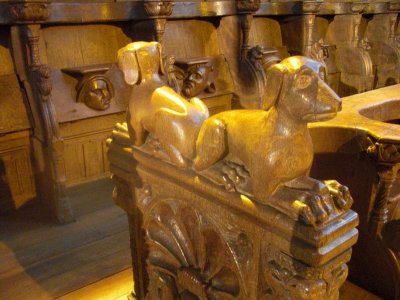
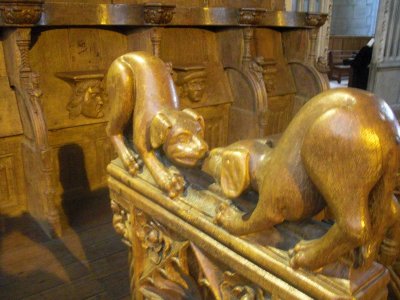 The boiseries were indeed wonderful. In particular, the choir stalls were carved with life-size high relief figures of saints, as well as with fanciful faces and creatures. For some reason, on one side of the choir, the animals (some real and some fanciful) faced each other with grimaces but on the other placidly ignored each other. The life-size human figures were just above what you can see here, one per stall, above the carved faces in the background. (Those faces are on the undersides of the little fold-down seats in the stalls.)
The boiseries were indeed wonderful. In particular, the choir stalls were carved with life-size high relief figures of saints, as well as with fanciful faces and creatures. For some reason, on one side of the choir, the animals (some real and some fanciful) faced each other with grimaces but on the other placidly ignored each other. The life-size human figures were just above what you can see here, one per stall, above the carved faces in the background. (Those faces are on the undersides of the little fold-down seats in the stalls.)
The church also had a black madonna and child, wearing real fabric gowns.
We had dinner that night at the Auberge Bressane, which was, as advertised, directly across from the Monastère Royale de Brou. The first amuse-bouche, with David's champagne, was puff pastry fleurons of cheese and anchovy. The second, which I apparently failed to photograph, was little glasses filled with a coarse purée of cooked beets sharpened with lime juice and topped with unsweetened whipped cream.
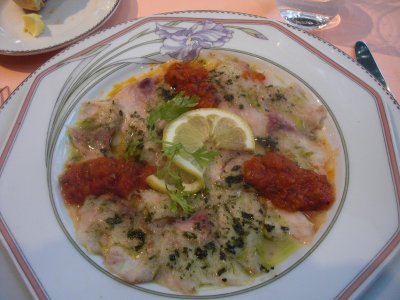
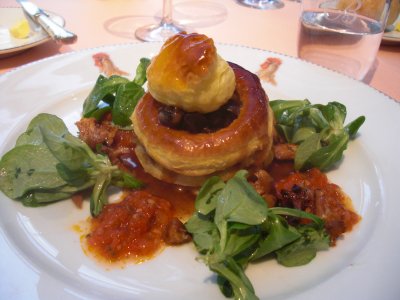 First course, David: Carpaccio of bar (sea bass), marinated in lemon, olive oil, and basil and cooked only by being spread on a very hot plate, garnished with a delicious warm tomato sauce. Amazingly delicate texture.
First course, David: Carpaccio of bar (sea bass), marinated in lemon, olive oil, and basil and cooked only by being spread on a very hot plate, garnished with a delicious warm tomato sauce. Amazingly delicate texture.
First course, me: Vol au vent (i.e., puff-pastry case) filled with snails and ragout of mushrooms, garnished with "mâche (i.e., lamb's lettuce). Delicious!
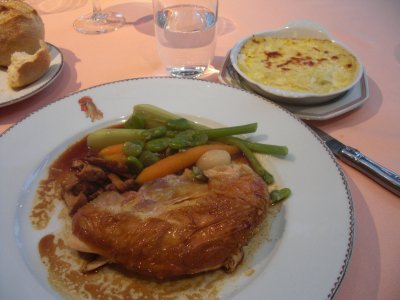
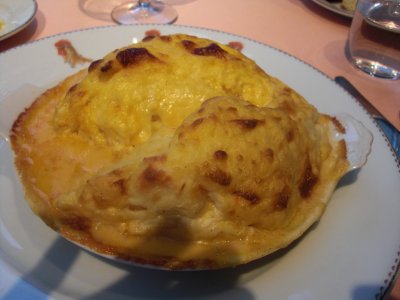 Main course, David: Roasted Bresse chicken (most of the restaurants we've been to served "poulet" de Bresse; this one seemed to serve only "poularde" de Bresse) with "vegetables of the moment" and a separate dish of gratin Dauphinois (scalloped potatoes).
Main course, David: Roasted Bresse chicken (most of the restaurants we've been to served "poulet" de Bresse; this one seemed to serve only "poularde" de Bresse) with "vegetables of the moment" and a separate dish of gratin Dauphinois (scalloped potatoes).
Main course, me: Quenelles de brochet (i.e., pike dumplings). I'm really glad I waited to order them here and not back in Lyon. These are quenelles de brochet as I (and Julia Child) understand them to be made. Here two of them crowd each other in the dish. They started out perhaps the size of lemons, but in the final cooking process swell to the size of (football-shaped) grapefruit. They were fluffy inside, served ferociously hot, and strangely, accompanied by exactly nothing—just quenelles, sauce, and not so much as a sprig of parsley. Delicious, but if I hadn't known, I wouldn't have been able to tell you they contained fish; I make them at home with chicken, and it now occurs to me that I could use those nice trout Publix has been carrying. The next day was market day in Bourg, so I went after breakfast, while David slept on, and a guy there was selling fresh trout, trout quenelles (prepoached and ready for their final cooking and puffing in sauce), and "friture" of trout (tiny fingerling trout, gutted and ready to be fried whole).
This was David's third try at Bresse chicken—poularde from a named supplier, roasted (which ought to bring out its flavor), served proudly at the epicenter of and by a specialist in the variety—and we reluctantly conclude that, sigh, it's just chicken. We don't get what the French are on about when they swoon over Bresse chicken.
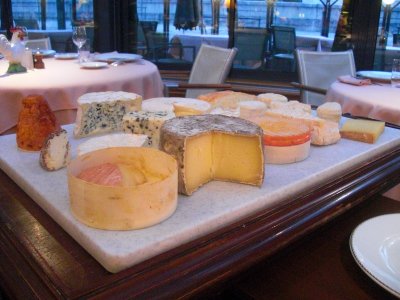
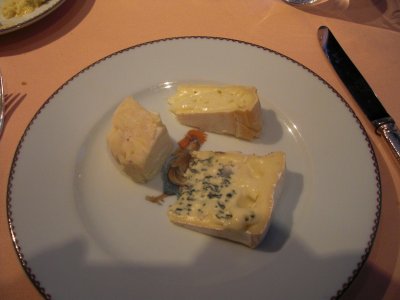 Here's the Auberge Bressane's cheese selection, pretty typical of the collections we've seen on this trip. Note the bright-orange boulette d'Avesne and the round boxes of Époisse variations.
Here's the Auberge Bressane's cheese selection, pretty typical of the collections we've seen on this trip. Note the bright-orange boulette d'Avesne and the round boxes of Époisse variations.
From it, I chose Brillat-Savarin, Époisse (in the balsa-wood box in the foreground), and an uncharacterically tall (but outstandingly delicious) Saint Marcellin.
David chose (his plate shown here), clockwise from the top, Saint Nectaire, one of the blues, and (I think) Saint Marcellin. Note the chicken painted on the plate.
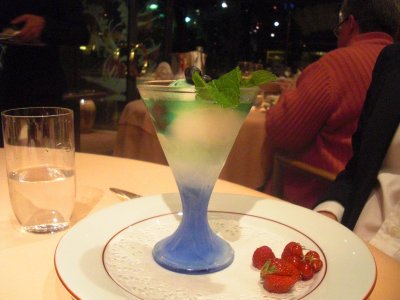
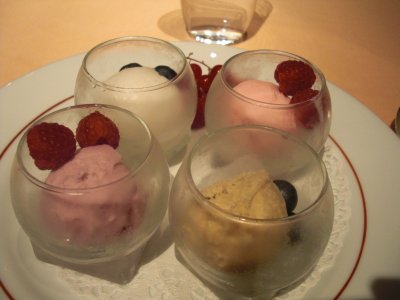 Dessert, David: Sorbet of green chartreuse and génépi made by the same monks of Chartreux. Génépi is a wormwood liqueur, like absinthe. Chatreuse is described as an "augmented" génépi. Anyway, it was so strong that David dumped out the crystallized ginger onto the mignardise tray so that he could use the glass it was in to spoon some of the liqueur out of his dish.
Dessert, David: Sorbet of green chartreuse and génépi made by the same monks of Chartreux. Génépi is a wormwood liqueur, like absinthe. Chatreuse is described as an "augmented" génépi. Anyway, it was so strong that David dumped out the crystallized ginger onto the mignardise tray so that he could use the glass it was in to spoon some of the liqueur out of his dish.
Dessert, me: Sorbets in "flavors of the forest floor"—rose, violet, licorice, and juniper! The licorice is white, the juniper brown. Delicious and definitely an interesting concept.
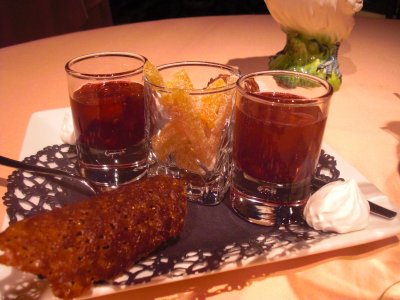
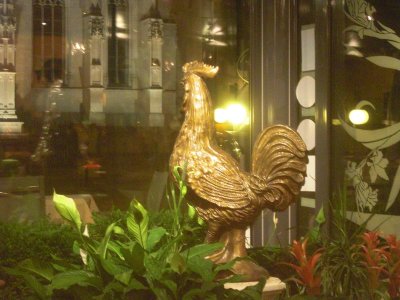 The mignardises were raspberries in syrup, tuile cookies, little crisp meringues, and a glass of strips of crystalized ginger.
The mignardises were raspberries in syrup, tuile cookies, little crisp meringues, and a glass of strips of crystalized ginger.
At the right is the three-foot chicken that looks out at the street through the restaurant's front window. I don't know what it was actually made of, but it looked like metal, sort of between brass and bronze in color. The walls were hung with many paintings of chickens, and every available surface bore chicken figurines of many sizes and colors.
previous entry
List of Entries
next entry

 On the way, we drove on several stretches of old Roman road, now tarmac'd over but recognizable by their resolute rectilinearity; they're incredibly durable, but no road can stand 1500 years of neglect and stay smooth. They can, however, remain straight, as this one has (the plane trees have probably been replaced a couple of times).
On the way, we drove on several stretches of old Roman road, now tarmac'd over but recognizable by their resolute rectilinearity; they're incredibly durable, but no road can stand 1500 years of neglect and stay smooth. They can, however, remain straight, as this one has (the plane trees have probably been replaced a couple of times).
 We found lunch at Le Scarron (Paul Scarron, 1610-1660, was a poet who was born and died in Paris, but maybe he worked in Bourg for a while in between), on our way to the Office de Tourisme. Mine was the usual "Gourmande" (this one with duck-breast ham, foie gras, raw mushrooms, and asparagus). I forget the name of David's, but it had raw ham, dried (and fresh) tomato, walnuts, and excellent Tome de Savoie (I definitely taste the kinship with Sweetgrass Dairy's Thomasville Tomme).
We found lunch at Le Scarron (Paul Scarron, 1610-1660, was a poet who was born and died in Paris, but maybe he worked in Bourg for a while in between), on our way to the Office de Tourisme. Mine was the usual "Gourmande" (this one with duck-breast ham, foie gras, raw mushrooms, and asparagus). I forget the name of David's, but it had raw ham, dried (and fresh) tomato, walnuts, and excellent Tome de Savoie (I definitely taste the kinship with Sweetgrass Dairy's Thomasville Tomme). 
 On the way there, we passed this straw chicken in a wine-store window. Chickens are a major theme of design and decoration in the town. All the restaurant plates have chickens on them; both restaurants we ate dinner in had chicken art on the walls (and every other surface).
On the way there, we passed this straw chicken in a wine-store window. Chickens are a major theme of design and decoration in the town. All the restaurant plates have chickens on them; both restaurants we ate dinner in had chicken art on the walls (and every other surface). 
 The walking tour mostly featured Bourg's medieval houses, recognizable by their half-timbering or, on the more prosperous, stucco-covered ones, the little "tourelles" at the corners—small round towers, typically starting above ground level, protruding from the corners of the houses. You can see the decorative conical bottom of one just above this new tile roof, waiting on the sidewalk to be installed.
The walking tour mostly featured Bourg's medieval houses, recognizable by their half-timbering or, on the more prosperous, stucco-covered ones, the little "tourelles" at the corners—small round towers, typically starting above ground level, protruding from the corners of the houses. You can see the decorative conical bottom of one just above this new tile roof, waiting on the sidewalk to be installed.
 The boiseries were indeed wonderful. In particular, the choir stalls were carved with life-size high relief figures of saints, as well as with fanciful faces and creatures. For some reason, on one side of the choir, the animals (some real and some fanciful) faced each other with grimaces but on the other placidly ignored each other. The life-size human figures were just above what you can see here, one per stall, above the carved faces in the background. (Those faces are on the undersides of the little fold-down seats in the stalls.)
The boiseries were indeed wonderful. In particular, the choir stalls were carved with life-size high relief figures of saints, as well as with fanciful faces and creatures. For some reason, on one side of the choir, the animals (some real and some fanciful) faced each other with grimaces but on the other placidly ignored each other. The life-size human figures were just above what you can see here, one per stall, above the carved faces in the background. (Those faces are on the undersides of the little fold-down seats in the stalls.)
 First course, David: Carpaccio of bar (sea bass), marinated in lemon, olive oil, and basil and cooked only by being spread on a very hot plate, garnished with a delicious warm tomato sauce. Amazingly delicate texture.
First course, David: Carpaccio of bar (sea bass), marinated in lemon, olive oil, and basil and cooked only by being spread on a very hot plate, garnished with a delicious warm tomato sauce. Amazingly delicate texture.
 Main course, David: Roasted Bresse chicken (most of the restaurants we've been to served "poulet" de Bresse; this one seemed to serve only "poularde" de Bresse) with "vegetables of the moment" and a separate dish of gratin Dauphinois (scalloped potatoes).
Main course, David: Roasted Bresse chicken (most of the restaurants we've been to served "poulet" de Bresse; this one seemed to serve only "poularde" de Bresse) with "vegetables of the moment" and a separate dish of gratin Dauphinois (scalloped potatoes).
 Here's the Auberge Bressane's cheese selection, pretty typical of the collections we've seen on this trip. Note the bright-orange boulette d'Avesne and the round boxes of Époisse variations.
Here's the Auberge Bressane's cheese selection, pretty typical of the collections we've seen on this trip. Note the bright-orange boulette d'Avesne and the round boxes of Époisse variations.
 Dessert, David: Sorbet of green chartreuse and génépi made by the same monks of Chartreux. Génépi is a wormwood liqueur, like absinthe. Chatreuse is described as an "augmented" génépi. Anyway, it was so strong that David dumped out the crystallized ginger onto the mignardise tray so that he could use the glass it was in to spoon some of the liqueur out of his dish.
Dessert, David: Sorbet of green chartreuse and génépi made by the same monks of Chartreux. Génépi is a wormwood liqueur, like absinthe. Chatreuse is described as an "augmented" génépi. Anyway, it was so strong that David dumped out the crystallized ginger onto the mignardise tray so that he could use the glass it was in to spoon some of the liqueur out of his dish.
 The mignardises were raspberries in syrup, tuile cookies, little crisp meringues, and a glass of strips of crystalized ginger.
The mignardises were raspberries in syrup, tuile cookies, little crisp meringues, and a glass of strips of crystalized ginger.